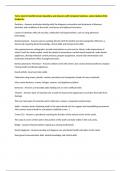Terms Used in Dentistry Exam Questions and Answers with Complete Solutions. Latest Update 2024.
Graded A+
Dentistry - Answers profession dealing with the diagnosis, prevention and treatment of diseases,
disorders and conditions of the teeth, oral tissues and adjacent structures.
Careers in dentistry offer job security, satisfaction and opportunities, such as using advanced
technology.
Dental Assistant - Answers person working directly with the dentist and increasing their efficiency; a
diverse job requiring dental knowledge, clinical skills and interpersonal skills.
May expose/process radiographs, provide instructions on oral care for clients, make impressions of
clients' teeth for study models, assist the dentist in procedures, control dental materials, make dental
appliances, develop infection control protocol, prepare equipment, record client information and
treatment and perform office management tasks.
Dental Laboratory Technician - Answers seldom work with clients, but creates dental prostheses (replace
missing teeth) and dental appliances.
Needs artistic, hand and vision skills.
Fabricates using waxes, plastics, metals, porcelains and composites (made of many materials).
May create dentures, crowns, bridges, veneers, and appliances/splints.
Dentures - Answers a removable plate holding one or more artificial teeth.
Veneers - Answers layer of material over a tooth to improve the appearance or protect the tooth from
damage.
The two main types of material used to fabricate a veneer: composite and porcelain.
Splint - Answers device fastening teeth in the same dental arch for support and immobilizing movement.
May connect natural teeth to a prosthesis (artificial crown...)
Crown (Cr) - Answers a prosthesis restoring the function of the natural crown of the tooth.
The natural crown of the tooth is the portion of the tooth normally visible in the oral cavity.
Bridge - Answers fixed prosthesis replacing a missing tooth/teeth.
Dental Hygienist - Answers provide oral hygiene care and dental health education to the client.
Need good communication skills, dental knowledge and clinical skills.
,May access and chart oral conditions, review the client's health history, expose/process dental
radiographs, instruct clients in hygiene techniques, provide nutritional dental counseling, remove
calculus and plaque and apply preventive materials (fluoride, sealants)
Calculus - Answers rough, hardened dental plaque combined with minerals in saliva.
Cannot be removed with regular brushing and flossing; must be removed by dentist.
Plaque - Answers soft, sticky deposit on tooth's surface; consists of saliva, bacteria, food, tooth paste
deposit...
Dentist - Answers must have scientific ability, work well with others and enjoy helping others.
After completing dental schools, dentists receive a doctor of dental surgery (DDS) degree or doctor of
dental medicine (DMD) degree.
May diagnose/treat diseases of the teeth and its tissues, tongue, lips and jaws, restore decayed teeth,
replace missing teeth with artificial materials, provide cosmetic procedures, perform corrective surgery
on the jaws and tissues, straighten teeth and perform oral hygiene procedures with instructions.
Dental Public Health - Answers a specialty area; dental health prevention, education and treatment
programs at the community level.
Endodontics - Answers a specialty area; treatment of diseases of the pulp and periapical tissues.
Pulp - Answers tooth tissue; the innermost tissue of the tooth; composed of blood vessels, nerves,
lymphatics and connective tissue.
Is very large in newly erupted teeth, so it is more sensitive to thermal changes.
As the tooth ages, the amount of dentin increases and the pulp becomes smaller.
Pulp Chamber - Answers the pulp within the crown of the tooth.
Pulp Canal - Answers pulp in the roots of the tooth.
Usually corresponds with the number of roots of the tooth.
Periapical Tissues - Answers surrounds the apex of the root of the tooth.
Apex - Answers at the end of the root located farthest away from the crown.
Oral and Maxillofacial Pathology - Answers a specialty area; research, identification and management of
diseases affecting the oral structures.
Oral and Maxillofacial Surgery - Answers a specialty area; surgical treatment of diseases, injuries and
defects of the oral and maxillofacial region.
, Maxillofacial Region - Answers area around the jaws and face.
Periodontal Diseases - Answers diseases of the supporting and surrounding tissues of the teeth; gingiva,
periodontal ligament and alveolar bone.
It's first stage is gingivitis, than periodontitis.
Signs include; gingival swelling, redness, bleeding, recession, loss of teeth and bad breath/taste
Gingival Recession - Answers the drawing back of the gingiva from the neck of the teeth, exposing the
root surfaces.
Sign of periodontal diseases
Malocclusions - Answers abnormal relationship of the teeth when biting or closing.
Pediatric Dentistry - Answers comprehensive dental care of infants and children through adolescence
(puberty), including clients who have special needs.
Periodontics - Answers prevention and treatment of periodontal diseases.
Orthodontics and Dentofacial Orthopedics - Answers correction of tooth alignment and malocclusions.
Prosthodontics - Answers replacement of missing teeth and oral structures with artificial substitutes.
Deciduous Dentition - Answers primary teeth; first set of teeth- 20.
First teeth erupt at about six months and all twenty teeth have erupted by about two and a half years of
age.
Ten teeth in the maxilla, ten in the mandible
Maxillary Arch (Maxilla) - Answers upper jawbone.
Mandibular Arch (Mandible) - Answers lower jawbone.
Midsagittal Plane - Answers midline dividing the arches and separating the oral cavity into quadrants.
Permanent Dentition - Answers permanent teeth replacing the primary teeth that fall out from ages 6-
12.
After the primary teeth resorb, the permanent molars erupt distal to the primary molars and therefore,
do not replace the primary teeth. As the child grows, the jaws become longer and larger, creating more
space for additional teeth.
Consists of 32 teeth; begins to erupt at age six. With the exception of third molars, all permanent teeth
should have erupted by ages 12-14.




